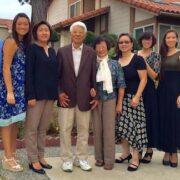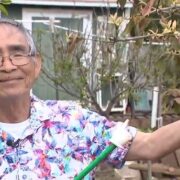Maki-e, an art for the soul
by Bernard Lyn 林秋雄


PREFACE
Someone once asked Artur Schnabel, “How do you play Mozart?” And the pianist simply replied, “With heart.” Artur Rubinstein did not play Chopin – he sang it! One of our Maki-e artists, Kenji Yamamoto, says that Maki-e should be painted with heart. I have now brought the heart of Japan to your hand with Maki-e, an art for the soul, music for your eyes, and I wish to share my enjoyment of these beautiful pieces with you.
Maki-e (pronounced “Ma” as in “mat”, “Ki” as in “kit” and “e” as in “Edward”) was created by Japanese Urushi (pronounce “U” as in “wood”, “Ru” as in “rule” but with a short vowel, and “shi” as in “sit”) people in the 8th century, and even today Maki-e can only be found in Japan due to its complicated techniques of painting which require both exceptional talent and incredible endurance. “Maki” of Maki-e means “sprinkling” or “sowing”, and “e” means “paintings”. Sprinkling gold or silver powders is one of the special characteristics of Maki-e. A good Maki-e artist needs not only natural talent, but has also usually begun training in the art from a very early age. Many years of apprenticeship to his master are required before he is able to begin creating his own Maki- e. Just as an athlete needs both healthy mind and healthy body, it is widely believed that Maki-e artists need strong cultural backgrounds in order to produce good Maki-e work. It is therefore expected that Maki-e artists cultivate their artistic characters by learning Haiku (short form of poetry), tea ceremony, and Japanese calligraphy.
A tea house of Sado (or Chado), a tea ceremony is designed under the spirit of simplicity. The gavel walk that leads to the tea house is designed also under the same spirit without flowers or any decoration along the walk. The doorway into the house is extremely small, maybe only 4 feet high and less than 3 feet wide. One has to carefully bend one’s body forward in order to pass through it, suggesting that the guests invited to the tea house should attend with a humble mind. With this mind, I have learned about Maki-e, theme related history or folklore and nature for the past three years.
I’m neither an artist nor a collector of any sort. I’m just an ordinary lover of beautiful things such as Maki-e or Shippoyaki (Japanese cloisonne) and I often feel more moved by a small Maki-e painting on pens or Natsume (tea containers) than big pieces of Sumi-e (Japanese Ink Paintings) or oil paintings. However, I believe that it is essential to have a good knowledge of Maki-e before we really know Row to appreciate the art. I’m going to introduce more than 100 Maki-e designs on pens and other works such as Natsume by Maki-e artists. I have tried to provide as much detailed information about Maki-e techniques as possible, so that we all will understand what makes Maki-e so special. Maki-e shi need to be recognized by the art society, especially by true Maki-e lovers. They need to be encouraged by Maki-e lovers’ appreciation of their works. Although there are many art exhibitions in Japan for artists to show their works, these activities are limited to domestic appreciation and the chances of being recognized worldwide are very small. My highest expectation for writing this book is that it will help the Maki-e artists receive more global recognition, and that there will be more Maki-e aficionados to share their joys with me.
There are at least thirty major Urushi/Maki-e centers throughout Japan, and they all boast their special techniques and their hundreds of years of making history. You can tell where the source for the object is by its design, patterns or Urushi painting. Some of them are of top quality and some are not. For instance, Hiraizumi in Iwate Prefecture is well known for their Hidehira-nuri designing with gold leaves, Yamanaka in Ishikawa Prefecture has the best lathing techniques for making wood bowls or any round-shaped containers such as Natsume or with various decorative designs, Johoji in Iwate Prefecture is famous for their Tame-nuri with one of the most dependable groundwork methods, Maki-ji (4-4) or Kamakura in Kanagawa Prefecture for their Kamakura-bori (2-23), Odawara also in Kanagawa is famous for their Suri-Urushi Shiage (2-10, 3-9) and Kiji Roiro Shiage (2-8) and so on. It will be very hard to find some specialty store which has Urushi wares from all those different centers in Japan. But this can be a good excuse for someone who likes to see all these by traveling around in Japan, and this is what I want to do in another three years.
The Urushi I talk about in this book are all related to Modern works only and many of them are not technically applicable to Urushi/Maki-e works on pens. And then, the works on pens are limited to only painted or Maki-e by our current artisans or artists. Urushi is expensive, but it is 100% natural and environmentally friendly. It is good for health and worthy of promoting in all kind of works.

Published in -/2003
Donated by Mr. Bernard Lyn 林秋雄 11/2016
Posted in 11/2016





